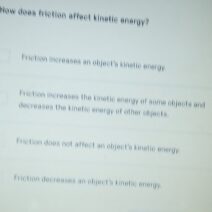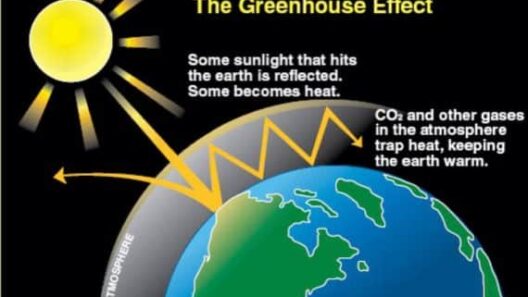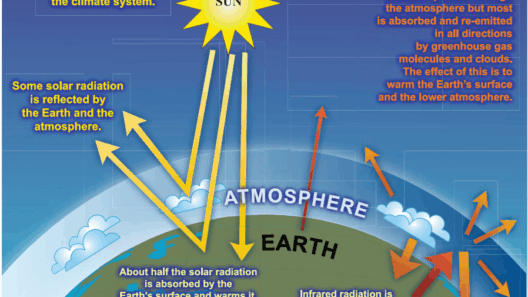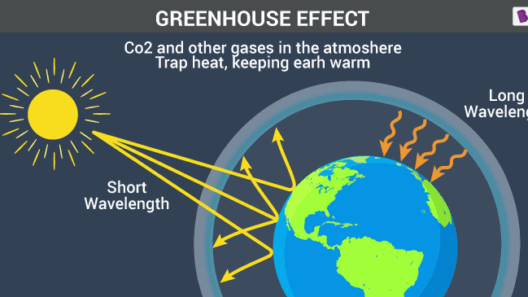The greenhouse effect is a fundamental concept that ensures the warmth of our planet, but this phenomenon is not unique to Earth. Within the vastness of our solar system, other celestial bodies also exhibit greenhouse characteristics. This article delves into the intricacies of the greenhouse effect on different planets, shedding light on how these processes shape their environments.
As we explore the atmospheric dynamics of Venus, Mars, and Titan, one cannot help but marvel at the superficial similarities and poly-dimensional differences, evoking curiosity about how the same principles can result in such divergent realities.
The Enigmatic Greenhouse Effect on Venus
With surface temperatures soaring around 900 degrees Fahrenheit, Venus stands as the quintessential illustration of an extreme greenhouse effect. Enveloped in a thick atmosphere composed primarily of carbon dioxide, with traces of sulfuric acid clouds, Venus resembles a hellish landscape more than the paradise idealized in art and literature.
This dense atmosphere creates an extraordinarily potent greenhouse effect. Solar radiation penetrates the atmosphere and warms the planet’s surface. Unfortunately, this warmth struggles to escape due to the overwhelming presence of greenhouse gases, akin to a blanket that stifles the escape of heat. As a result, nearly 97% of the solar energy absorbed is trapped, creating a perpetual cycle of heat retention.
Understanding this phenomenon provides insight into planetary atmospheres and the delicate balance of gases that propagate life. The tragic irony of Venus lies in its proximity to Earth. Both planets formed around the same time and possess comparable sizes, but the divergent paths each took have led to drastically different outcomes. The extreme conditions on Venus prompt researchers to question: what might Earth’s future look like if greenhouse gas emissions continue to rise unabated?
A Closer Look at Mars’ Thin Veil
Contrary to Venus, Mars offers a stark contrast, showcasing a much weaker greenhouse effect. Characterized by a thin atmosphere, primarily composed of carbon dioxide, Mars’s atmospheric pressure is less than 1% of Earth’s. This dramatic deficiency offers a tantalizing glimpse of how climate can alter the potential for life. On average, Mars hovers around a frigid -80 degrees Fahrenheit, showcasing how impactful the absence of sufficient greenhouse gases can be.
Yet, Mars does feature an intriguing layer of complexity. During Martian summers, temperatures can spike, and despite its thin atmosphere, the volatile seasonal variations allude to the involvement of greenhouse processes—albeit much more subdued than on its cloud-covered counterpart, Venus. Dust storms, along with ice and carbon dioxide sublimation, play transient roles that can momentarily enhance the greenhouse effect. This brief interlude during warmer seasons raises essential questions about Mars’ past climate: Did it once harbor a robust atmosphere capable of supporting liquid water?
The Viking missions of the 1970s and subsequent explorations continue to enrich our understanding of Mars’ dynamic environment. Each mission exposes more mysteries hidden within its canyons and valleys, igniting curiosity about the potential for past life and the planet’s propensity for atmospheric evolution.
A Journey Through Titan’s Ethereal Murk
On Saturn’s largest moon, Titan, the natural world unfolds in ways that defy Earthly logic, yet echoes the greenhouse effects so familiar to us. Titan boasts a dense atmosphere filled with nitrogen and methane, presenting a strikingly different context for exploring greenhouse phenomena. Here, the complexities of temperature regulation emerge from the interplay of various elements, creating a palette of aesthetic beauty ripe for exploration.
The surface temperature hovers around -290 degrees Fahrenheit, an inhospitable zone by Earthly standards yet ideal for the formation of liquid methane lakes and rivers. Titan’s atmosphere induces a mild greenhouse effect, ensuring that this unusually frigid moon remains hospitable for organic chemistry. The presence of methane in the atmosphere acts similarly to carbon dioxide on Earth, trapping heat and contributing to a delicate warmth—if “warmth” is even the appropriate term in such a frigid expanse.
The visual surrealism of Titan captures the imagination, leading one to ponder its implications for astrobiology and the potential for life. What forms could life take in such a world shrouded in opaque murky clouds? In framing our inquiries around Titan, we ask ourselves not merely about sustenance but also creativity—the innovative role of extreme conditions in fostering unique life forms.
Conclusion: The Broader Implications of Greenhouse Phenomena
As we dissect the intricate layers of the greenhouse effect across Venus, Mars, and Titan, it becomes evident that understanding these dynamics is more than an academic exercise. It presses us to confront existential questions regarding Earth’s future amidst a climate crisis. The lessons to be learned from the fates of these celestial bodies are manifold. They serve as cautionary tales, bearing witness to the consequences of greenhouse gas accumulation and the potential paths of planetary evolution.
Moreover, as we seek to enrich our own planet’s future, the tales of these other worlds offer hope and warnings alike, compelling us to take deliberate action. The art of observation extends beyond our home and into the cosmos—what we learn from these distant realms will echo back, shaping our understanding of Earth and driving home the imperative of safeguarding the delicate balance of our atmosphere while we still can.








